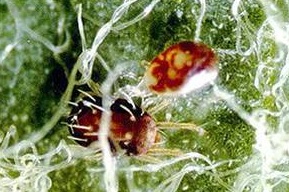
Features
Production
Vegetables
Whiteflies sabotage alarm system of plant
December 2, 2009 By Marg Land
 December 1, 2010 – When
December 1, 2010 – When
spider mites attack a bean plant, the plant responds by producing odours which
attract predatory mites.
December 1, 2010 – When
spider mites attack a bean plant, the plant responds by producing odours which
attract predatory mites.
These predatory mites then
exterminate the spider mite population, thus acting as a type of “bodyguard”
for the plant. However, if the plant is simultaneously attacked by whiteflies,
insects that are related to aphids, the plant becomes less attractive to the
predatory mites and therefore more vulnerable to spider mites. Together with
German colleagues, researchers from the Laboratory of Entomology at Wageningen
University published this discovery in the reputable journal Proceedings of the
National Academy of Sciences of the U.S.
 |
|
| Spider mites |
The research team studied
the strength of the plant’s “cry for help” through a chemical analysis of the
plant odour blend and found that one of the odour components (beta-ocimene) is
produced in much lower quantities if the plant is not only attacked by spider
mites, but also by whiteflies. The production of the odour decreases because of
a lower expression rate of the plant gene that codes for a crucial enzyme in
the production chain. When the researchers added ocimene to the odour of plants
which were attacked by both species, the attraction of predatory mites was
restored.
This recent breakthrough
demonstrates that there are also herbivores that can interfere with a plant’s
“cry for help,” possibly because the whiteflies attempt to interfere with the
plant’s defense system. Spider mites also produce more offspring on a plant
under attack by whiteflies. For a spider mite, there are therefore two reasons
why a bean plant which is being attacked by whiteflies is better than a bean
plant that is not being attacked: more offspring and fewer bodyguards. It is
therefore no surprise that the researchers found that the spider mite preferred
plants infested with whiteflies above plants without them.
The results of this study
are significant for integrated crop protection in which a combination of
methods can be used to fight various pests infesting a crop. Integrated crop
protection offers effective possibilities for environmentally safe pest
control, and is based on a solid knowledge of the crop system and its complex
of enemies. Once it becomes clear which insects weaken plant defence systems
and which strengthen them, more focused research on environmentally-safe pest
control will be possible, and people will no longer be caught off guard by
unexpected interference from some pest species.
The fact that plants “cry
for help” at all was discovered by the Wageningen research group in 1988. Since
that time, various laboratories worldwide have continued studying this topic
and it is now known that many – if not all – plants apply this type of defence.
The research conducted worldwide has focused primarily on the situation in
which plants are only attacked by a single herbivore. In nature, the situation
is much more complex, however. Plants are involved in a continuous arms race
with herbivorous insects which exploit the plant as food in a variety of ways.
Spider mites suck the contents of parenchyma cells. Contrary to what their name
suggests, whiteflies are not actually flies at all, but sap-sucking insects
related to aphids, which suck from the vascular tissue located deeper in the
plant. Some insects reinforce the plant’s defence system, which protects it
from other predators.
Print this page